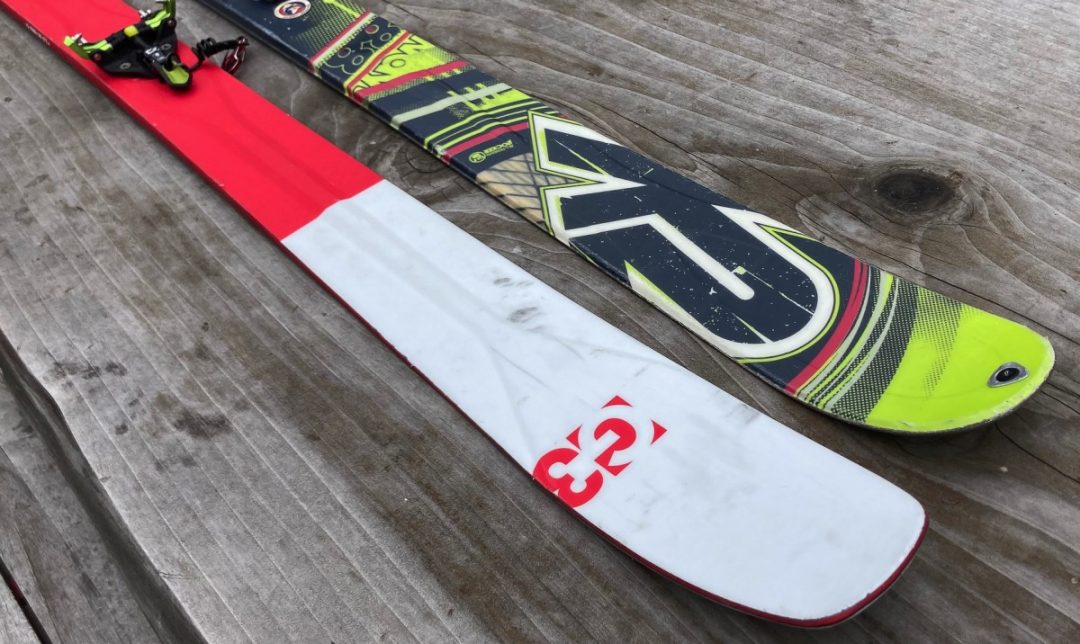
A tale of two similar but different skis. The 2012 K2 Wayback 88 (right) and the G3 FINDr 86 (left).
I know what I don’t like. Here’s one example: laying down the edge of a ski and feeling ho-um. It’s not like turning an ocean liner, but maybe more like an Oligarch’s yacht; it’s the sensation of carving firm snow with a 2″ x10″. Even with a metal edge, proper camber, and dampening, wider is sometimes too wide. But, when we get the sensation of a refined skinnier board under our feet, well, I’m hoping, in contrast, we all know what we like.
My likes trend towards specificity for skis, which means a board for this or maybe that; rarely both. For a time, however, I owned a quiver of one: the 2012 K2 Wayback 88. The reasons for this singular quiver were both financial (skis are pricey) and subjective due to the high-quality turns provided in most conditions. The 2012 Wayback 88’s straight tail, traditional camber underfoot, and a dash of tip rise = stable, enough float, and great edge hold. And for its time, maybe not so hefty in weight. But now I cringe. With older Dynafit TLT Turns and thick all-nylon BD carpets for skinning, each ski tips scales near 2175g. Skis and bindings together average 1945g.
I eventually pivoted towards lighter skis. It wasn’t necessarily a pivot towards better skis. As a matter of fact, it was not.
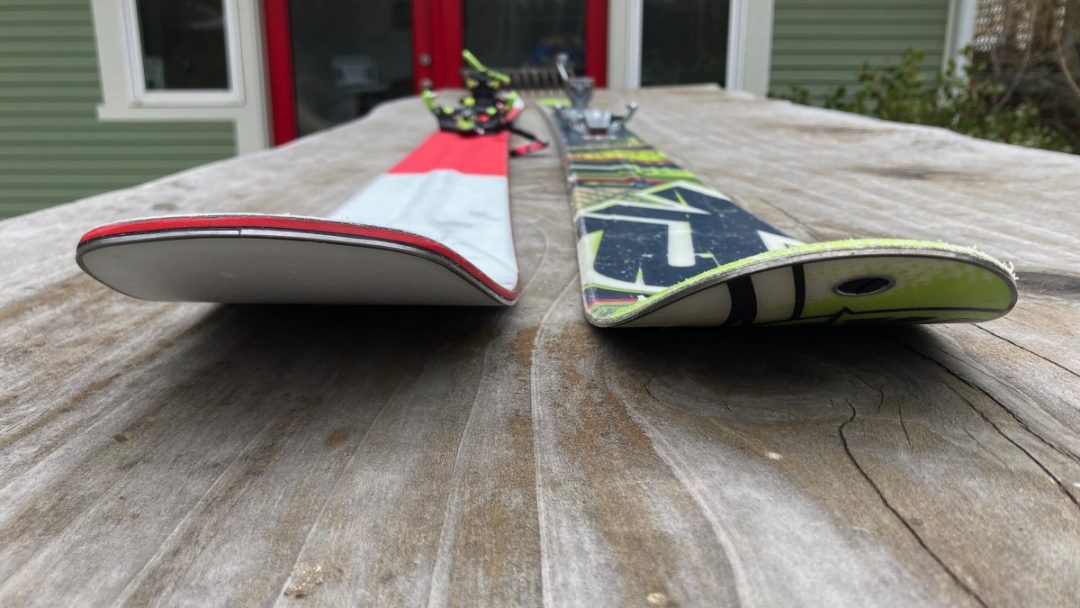
A head on shot of the FINDr 86 (left) and 2012 K2 Wayback 88 (right). The FINDr 86 offers more tip rise.
By 2022, I still sought a Wayback 88 replacement. This review, though, is no requiem—I assure you. But I do recall the last time I used the Waybacks. This Thanksgiving, there was enough snow on Mt. Bachelor (I think the mountain finally opened on Dec. 13th) to skin up and ski top to bottom. Which is to say, it was a perfect 2012 Wayback 88 snowpack in its thinness and firmness. That’s a confident ski.
The G3 Pivot
In learning about G3 on a call in October, we discussed testing and reviewing some skis. “Send me a priority list,” I recall the kind person on the call saying. In the ten times I likely went to their website to read up on specs, powder boards spoke the loudest, seemingly raising their hands and trying to get my attention. They nearly did.
I queried about the following boards: “SLAYR 114 in a 178 or 185cm. FINDr 86 in 172 or 177 for long spring missions…Possibly a SEEKr 110 (180) for powder/softer snow days,” I emailed.
“I think the SEEKr and the FINDr are both great options,” came the reply. “The FINDr 86 doesn’t get talked about enough and is an awesome choice for spring missions for sure, but I don’t want you to have to wait to ski on it, so if you’d prefer the SEEKr I can certainly send that over.”
(This is a fun job.)
By the time I pulled the trigger, I had that rekindled affair with the Waybacks during Thanksgiving. I explained I was fine with the FINDr 86 in a 177, writing, “most times here, unless it dumps, a skinnier ski is in order. So I’m sure this ski will be in play prior to corn season.”
The FINDr 86 was in play and in play months before corn season. Like a premonition I wished never fulfilled, from late December until something like forever, it didn’t dump. It snowed maybe 8″. Skinnier skis were in order.
The Mission: finding a 2012 Wayback Replacement
FINDr 86 (177cm)—stats first.
-Weight (g): Ski 1= 1352g Ski 2= 1350g. That’s tight tolerances.
-Camber under center of ski: +6mm.
-Turning Radius: 18.2m.
-Dimensions: 122/86/109mm.
-Tip: Early rise running 26.5cm.
-Tail: early rise running 10.25cm.
-Bindings: G3 Zed9 with ski crampon adapters: 380g.
-Total package weight skis and bindings: 1730g; 215g lighter than my Wayback setup.
-Boots used: Fischer Transalp Pro, Travers Carbon, Salomon S/Lab MTN Summit.
Price: $979.00.
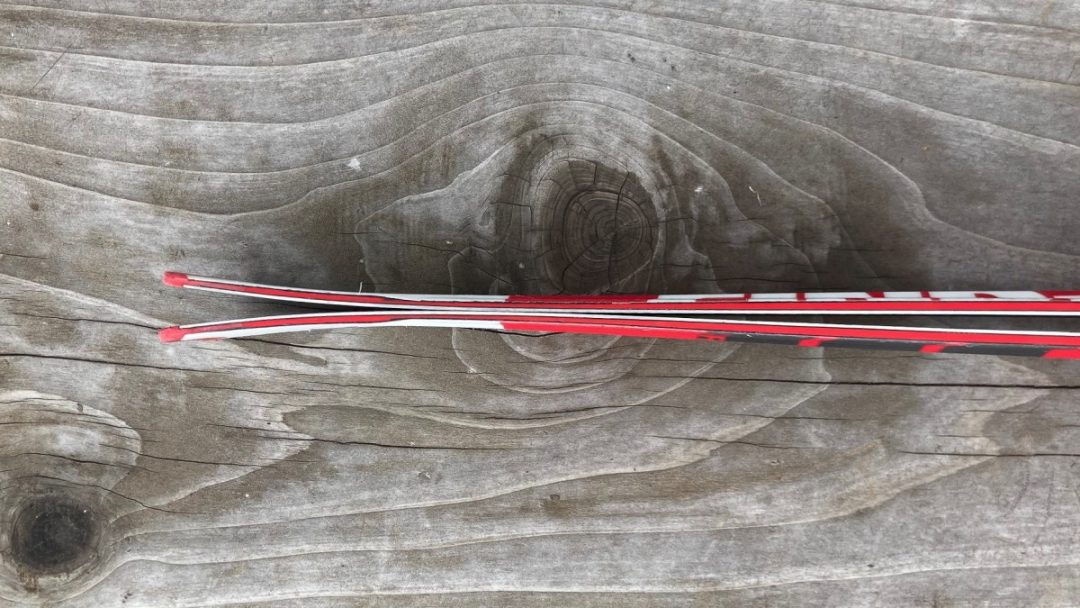
A shot showing the slight early rise of the G3 FINDr 86’s tails.
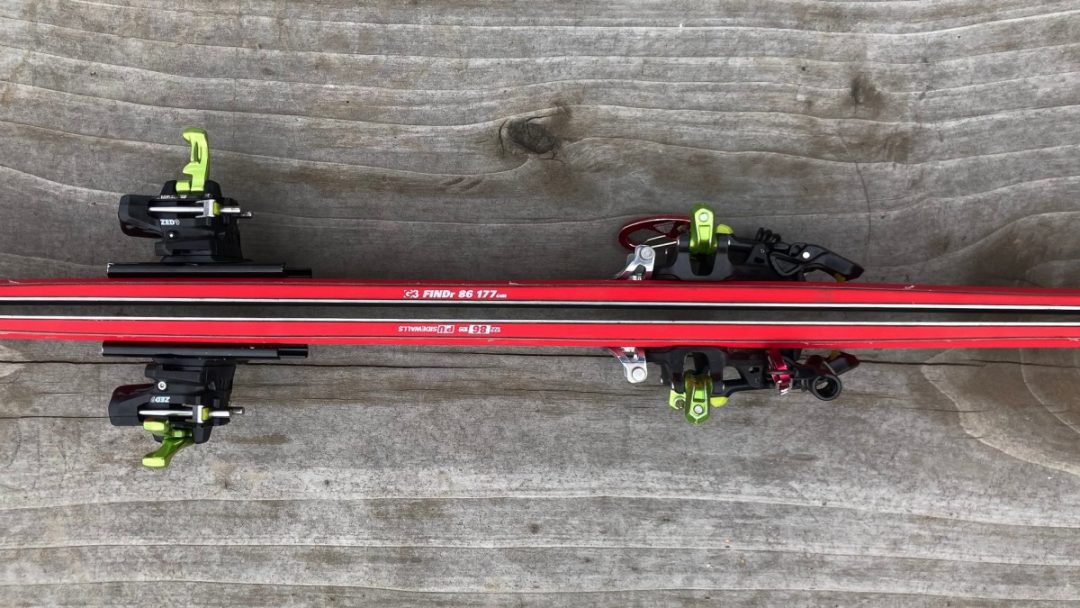
A shot showing the midsection of the G3 FINDr 86 and its traditional camber underfoot.
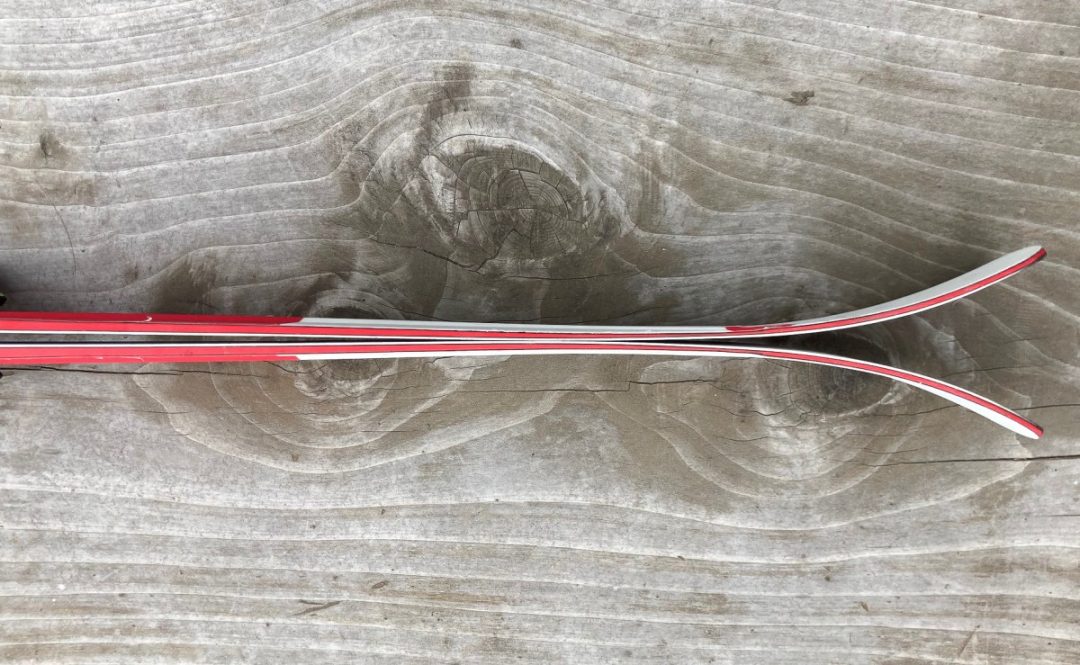
An image of the G3 FINDr 86’s tips and their modest tip rise.
The engineering
This is a wood core ski made from Poplar and Paulownia with two thin carbon sheets in the mix, a Titanal binding mount plate, sandwiched in what G3 calls a 3D design. The topsheet displays some “topography,” or “3D”; a ridge of varying widths runs from below the tip to the tail. A full polyurethane sidewall runs nearly the ski’s length, which the company says is more durable and offers better dampening properties than ABS, a more common sidewall material. A feature I like, but others might find extraneous, are the built-in magnetic contact points. There’s no need for a ski strap to fasten the skis together, that’s true, but by habit, I’m about 50-50 using a strap when slinging skis on the pack. But the contact points, so far, are reliable and can make ski-to-pack carries more efficient.
With the ski laid flat on a countertop, the tip rocker runs back 26.5 cm to a point where the ski base and counter contact. The tail rocker extends 10.25cm from the tail-end to where the base interfaces with the counter. Not precisely a flat tail, but suitable for digging the tails into firm snow for some types of anchors. G3 also reinforces the tail with a durable plastic that is amply notched to keep the skin tail secure.
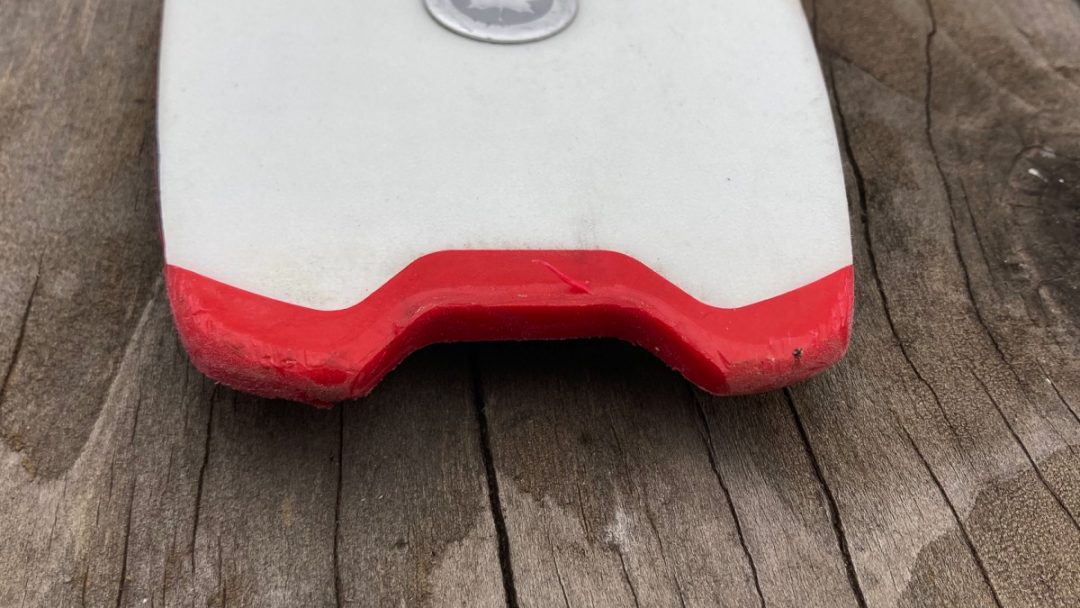
The tail is reinforced with a durable plastic and notched for secure skin tail hold.
Compared to my beloved Waybacks, the FINDr 86‘s tip rocker is more pronounced. I skied every powder storm for years with the Wayback and found the float suitable—I don’t live in the Wasatch. One contrast, though, the binding mount point is further back on the Waybacks than the FINDRs (the heel on the FINDr is mounted 4.5cm further from the tail, although both are adjusted for a similar BSL.) But, we are talking roughly ten years apart in design progression. Again, the exercise for me was to find a stable ski to replace the Waybacks, but with an even narrower range of high-value performance. Meaning, I wasn’t looking for all-mountain or powder-prowess. I wanted a stable ski at speed for firmer conditions, great edge hold on steeps, somewhat easy to jump turn, GS turn savvy, no chatter, good bite when driving aggressively, and damp skiing. Maybe a lot to ask.
I did ask, and for the most part, the FINDr 86 delivers.
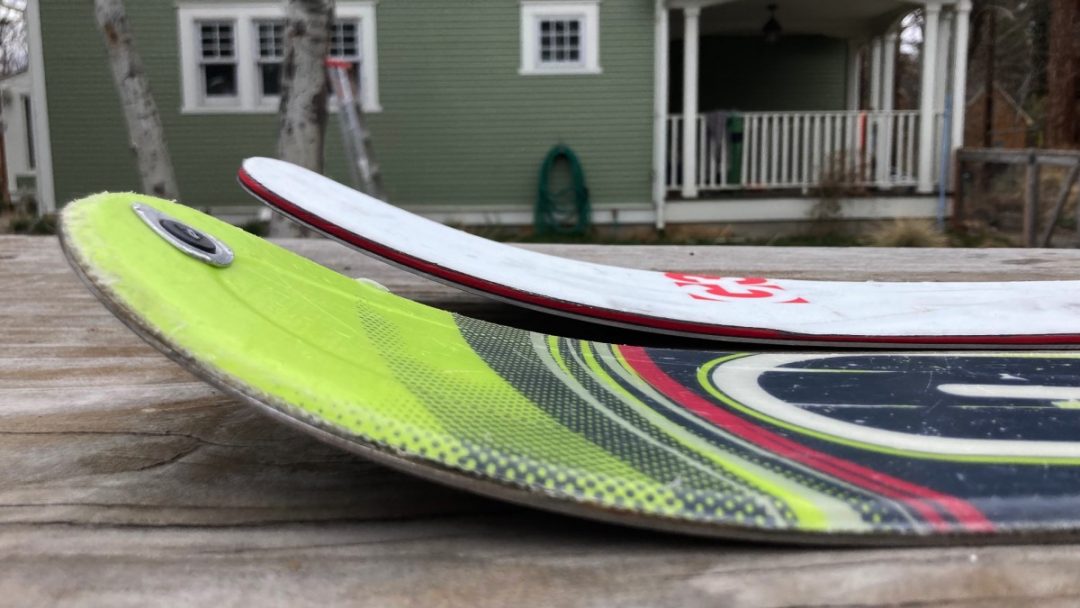
An image illustrating the difference in tip rise between the 2012 K2 Wayback 88, and the G3 FINDr 86 (background).
One qualifier, during those dark days of mid-winter high pressure, I did not find powder to test the FINDr 86s. And when it finally snowed and infilled more with a bit of wind loading, I’m hoping you forgive me, but I went seeking deep snow with a 107mm underfoot ski (review forthcoming). If you are a devout surfer, and it’s been howling onshore for months, and then the gods deliver offshore winds, a sizable swell, and no crowds, you’re likely not grabbing a boogie board.
The FINDr 86, however, is no box-store boogie board analog. Not to lose my train of thought here, with 86mm underfoot, even with the slight rise in tip and tail, I’m not taking these skis powder seeking.
Back to box stores. These stix scream high quality. From the top-sheet to the base, with as much beating my Waybacks have taken, I can see the FINDr 86s lasting a decade too when used as a go-to in firmer conditions or when looking for a damp stable ski, instead of taking an 80mm underfoot 300g lighter ski.
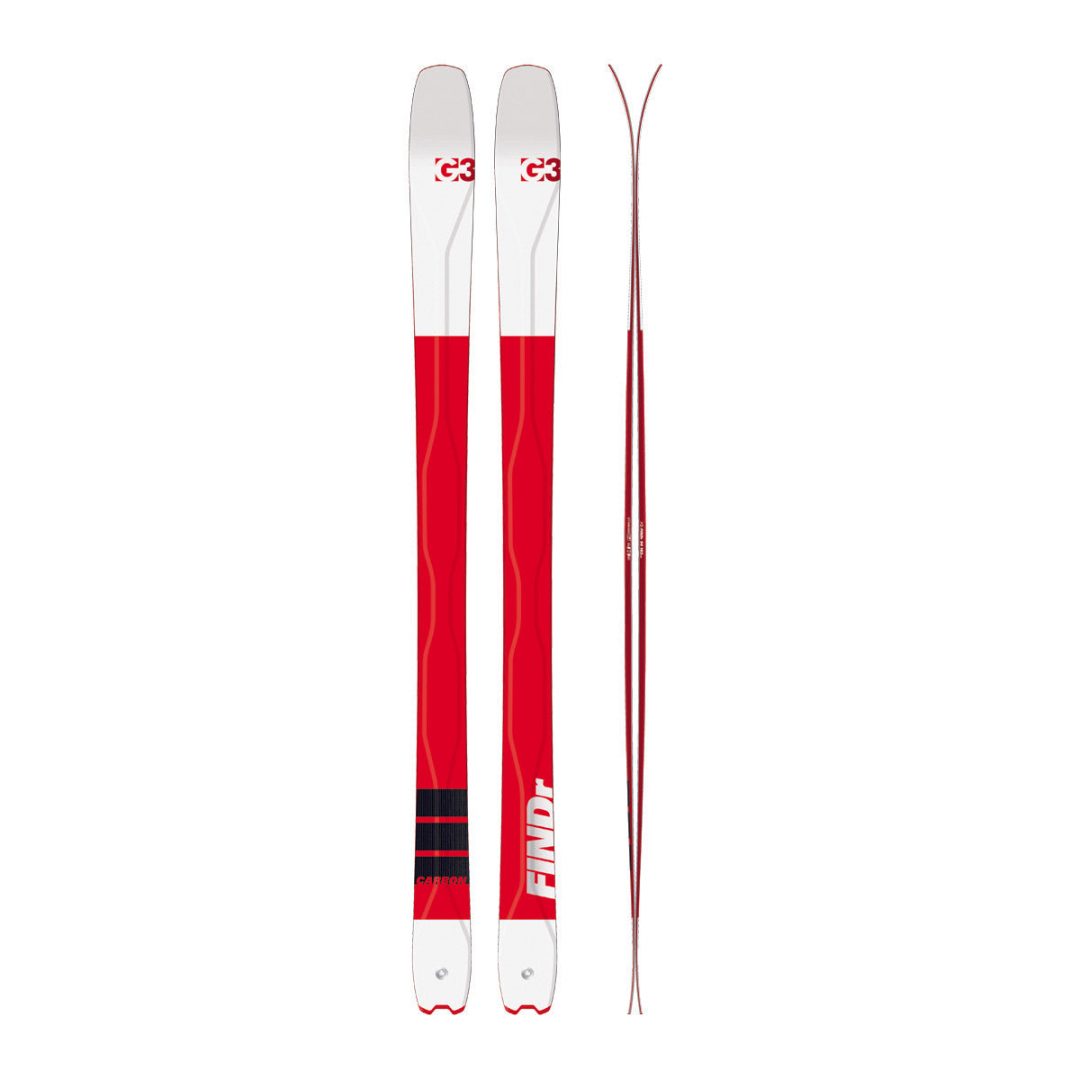
A clean and snazzy shot of the G3 FINDr 86. Photo: G3.
The dimensions between the FINDr and the 2012 Wayback 88s are pretty similar, too: 122/86/109mm (18.2 turn radius) to 124/88/108 (22m turn radius), respectively. Both skis taper in width 36mm from the tips to the midpoint. The Wayback’s width tapers 20mm from tail to midpoint, whereas the FINDr 86s taper 3mm more, with 23mm total.
The FINDr 86s have little if any taper in the tip and tail (meaning the ski’s widest point is near the tip/tail). This design makes the ski’s running length, or effective edge, relatively long. We’ll dig into this more, but on the surface, this makes the ski stable and nicely balanced, and when speeds accelerate and become sustained, the FINDr 86 holds its line while railing a macht-schnell GS turn.
In the field/On the Snow
Ice/Firm
I imagined the FINDr 86 for days when I wanted a longish turn radius and the ability to edge hold on ice and the firm slopes. Despite their rocker, which I would call just a bit beyond subtle, the edge grip was resolute. Jump turning and landing, the edges set great, with no evident tip instability. Even when slide-slipping, which I admit to doing from time to time, the FINDrs were stable and relatively damp; read that as no chatter. I found icy/firm conditions in troves during January and much of February.
This brings to mind my first day on the FINDrs. With thin snow in the backcountry, a group of us skinned up Mt. Bachelor. I deployed ski crampons on that day—it was a classic ice-coated volcano romp. We descended on what felt like boilerplate slightly softened by a groomer. The sensation was 2012-Wayback-88-like. Which, in my estimation, is a good thing. I was in control of the skis, not the other way around: despite the snow surface, they were confidence-inspiring, smile-inducing, speed-seeking, big turn fun.
What I like about the FINDr 86 is that it relies on tried and true design principles and modern material to make a damp, relatively light, and supremely skiable ski in the proper elements. Unless you consider magnetic contact points bling, there’s no flashiness, only down-to-earth skiability.
I then sought type-II fun in the backcountry, as I had ample terrain choices. With the high pressure and low angle January sun, slopes warming up were a non-issue. North, South, East, and West slopes, and all the in-between compass points, varied only by how much they were wind-scoured.
(To read more on the fun scale…here’s a good source.).
The price of the FINDr 86s, although currently on sale, is not insignificant, $979.00 usually, on sale for $734.00. And although trending toward the $1000.00 mark we often associate with space-age materials, the FINDr 86 does not ski like a carbon-infused wafer. It skis with more oomph and none of that carbon-buzz chatter. This ski was a friend when angles trended steeper, and surface conditions appeared to be prepped by a Zamboni. From a design perspective, the thickness of the ski in the tips and tails does not minimize as it would on some of the Movement Alp Track LTs, for example. And the relatively firm hand flex throughout its length supports the FINDr 86’s ski mountaineering chops I experienced.
The only thing I might have done differently is to go shorter in length to make the jump turns a smidge more flow-like when bringing the tips around.
The more variable stuff
In this snow category, think of variable conditions with a big helping of wind-affected snow. The ski provides some requisite pop and energy coming out of wider turns (a good thing) when the surface is more buffed. When things trended towards variable and breakable, the tips ran over inconsistencies sufficiently. If we can project personality traits onto an inanimate ski, reliability and diplomacy come to mind here.
It’s still an 86mm underfoot ski: there’s some surface area and heft to mitigate chop and breakable mank, but not a ton. Even with the slight rise in the tail, the tails could sink a bit if I didn’t balance properly over the ski’s center. In those situations, maybe like many of us, I checked my speed, focusing more on simply getting through a section and not making bliss turns (that’s the diplomacy part these skis allow for).
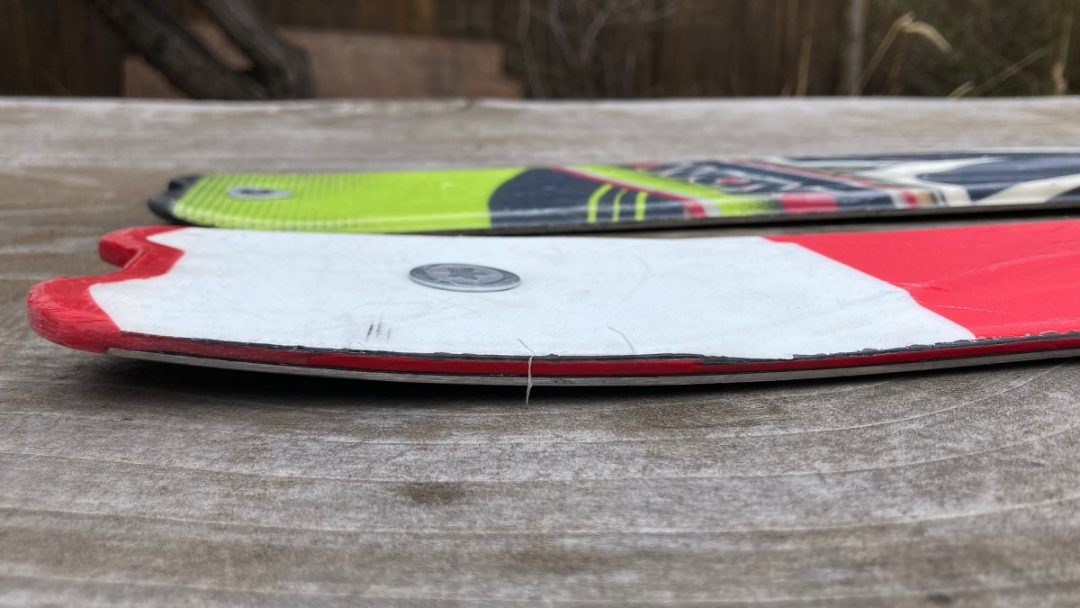
An image of the G3 FINDr 86 foreground and 2012 K2 Wayback 88 in the background. The K2 features a true flat tail, while the FINDr offers some rise.
Tourability
Initially, I skied the FINDr 86s with a nearly 1000g Fischer Travers Carbon. The boot was too soft for my liking when considering how I wanted to drive the ski, but it toured great. I then incorporated the Transalp Pros into the boot slot. This boot, for me, equates to better control at speed, but I’m hauling more weight. I know, picky. The Transalps and FINDr 86s paired up nicely. But, once I got my hands on the Salomon S/Lab MTN Summit boots (1200g and stiff), I found the combo of uphill ease and descending control I wanted with a ski like the FINDr 86. Here, “ski like this” should be qualified: the FINDr 86 is lightish as a flat ski, and even more so if mounted with a 200g binding, yet, it is not a 1000g ski mountaineering board. I think I found the sweet spot with the S/Lab’s stiffness and weight to make the FINDr work great on more extended tours when placing a premium on solid skiability. I’m likely not taking the FINDr 86s (177cm) on a long traverse but certainly would on a line-specific mission requiring lots of miles to access the objective.

With the skis connected via magnets, the tip rise is on display.
The In-Closing Part: (What happens to the Waybacks?)
The truth is, I wouldn’t say I like gear sitting around. I tried to give (for free) the Waybacks to a few friends over the years. No takers, and I’m not sure why. Maybe it was during the days of 110mm underfoot being too skinny. Or folks were waiting for Alaskan spines to materialize in non-geologic time—thank you, ski movies. Or was it during the all-mountain phase? All-mountain, the default choice for many to ski, you got it, all over the mountain, I guess means every condition too. That’s a lot of mountainous terrain and conditions for one ski to thrive. Anyhow, I even took the Waybacks to a local used gear shop, consigning for a fair price, I think $150.00. Still, no takers. I went in a few weeks later and reclaimed them. Imagining those keepsakes gone was killing me.
But, I’ve found my replacement in the G3 FINDr 86. Where I wasn’t bringing the Waybacks into real backcountry anymore due to the weight penalty, opting for the FINDr 86s is a no-compromise swap, all in a lighter feature set. What I like about the FINDr 86 is that it relies on tried and true design principles and modern material to make a damp, relatively light, and supremely skiable ski in the proper elements. Unless you consider magnetic contact points bling, there’s no flashiness, only down-to-earth skiability.
Postscript: To be continued…My friend Akeo arrives in a day for a fun outing to Steens Mountain. He’s just retired from a fruitful XC ski race career. He learned to tour on my Waybacks. There’s a potential home for them.
Jason Albert comes to WildSnow from Bend, Oregon. After growing up on the East Coast, he migrated from Montana to Colorado and settled in Oregon. Simple pleasures are quiet and long days touring. His gray hair might stem from his first Grand Traverse in 2000 when rented leather boots and 210cm skis were not the speed weapons he had hoped for. Jason survived the transition from free-heel kool-aid drinker to faster and lighter (think AT), and safer, are better.
